How to Win at Decluttering Sentimental Items Without Feeling Guilty
The struggle when decluttering pictures, heirlooms, keepsakes, children’s art, and other items with sentimental value is real. Here are some proven strategies to help you win at decluttering sentimental items and working through the guilt.
Keeping your home tidy is difficult enough. It gets even harder when you’re decluttering sentimental items. The memories and emotional attachments can make it nearly impossible to let go of anything.
Maybe you’ve kept every art project your child ever created or every letter and greeting card you’ve ever received. Maybe it’s your grandfather’s fishing poles and your Great Grandmothers China collection that reminds you of specific times or events in your life.
Whatever the actual item is, the sentimental attachments you’ve formed make it incredibly difficult to part with.
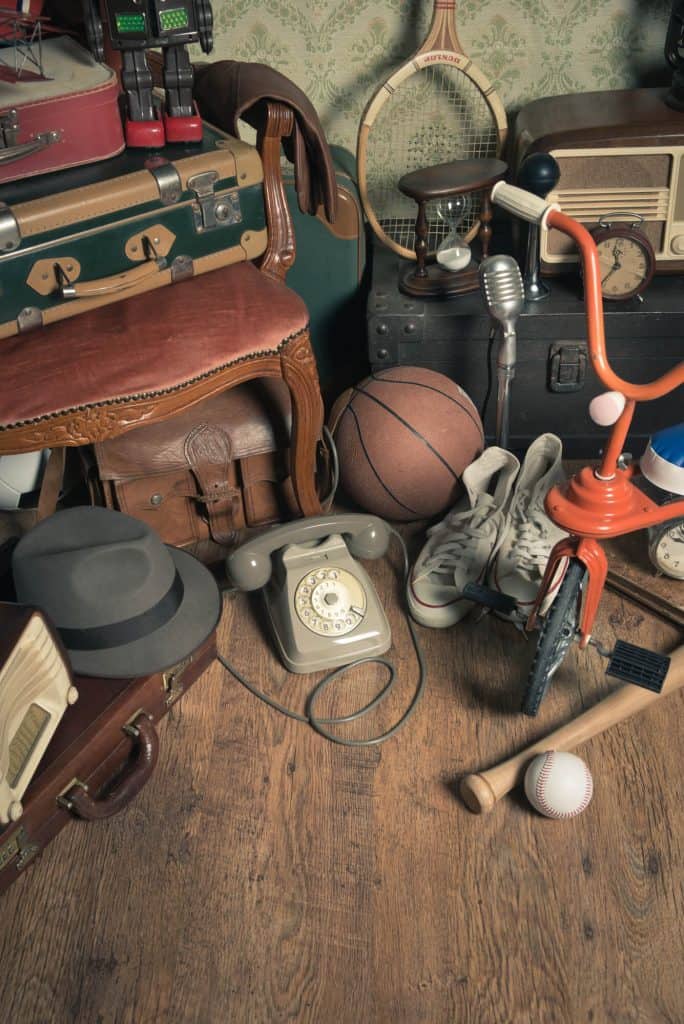
This post may contain affiliate links. Please see my disclosure policy for details.
The mere sight of these items can bring back years of memories and all of the emotions associated with them. Some make you happy recalling a wonderful tropical vacation or an annual White Elephant Christmas party with family and friends, and others might make you sad due to the loss of somebody close to you.
Holding on to too many of these items causes clutter and it can impact your mood, health, and life, as well as your home. It can make your home feel crowded and cramped.
When those items start feeling heavy and weighing on you in any way, it’s time to declutter those sentimental items and find a different way to preserve all of those memories.
Is Your Home a Storage Unit?
According to a report on census.gov, the average size of a single-family home in 1973 was approximately 1521 square feet. That size increased over the next several years to a whopping 2169 square feet by 2010.
A quick drive around my town would suggest the average size of a single-family home currently sits somewhere around the 2500+ square foot mark.
The increase isn’t because our families are getting bigger although I’m sure there are exceptions. Most of it’s because we obtain and keep way more stuff than ever before.
We’ve turned our homes into oversized, overpriced storage units and a lot of what we’re storing is sentimental clutter.
Here are some strategies to help you declutter those sentimental items and take back your square footage.
AVOID THE COMMON DECLUTTERING MISTAKES OTHERS MAKE!
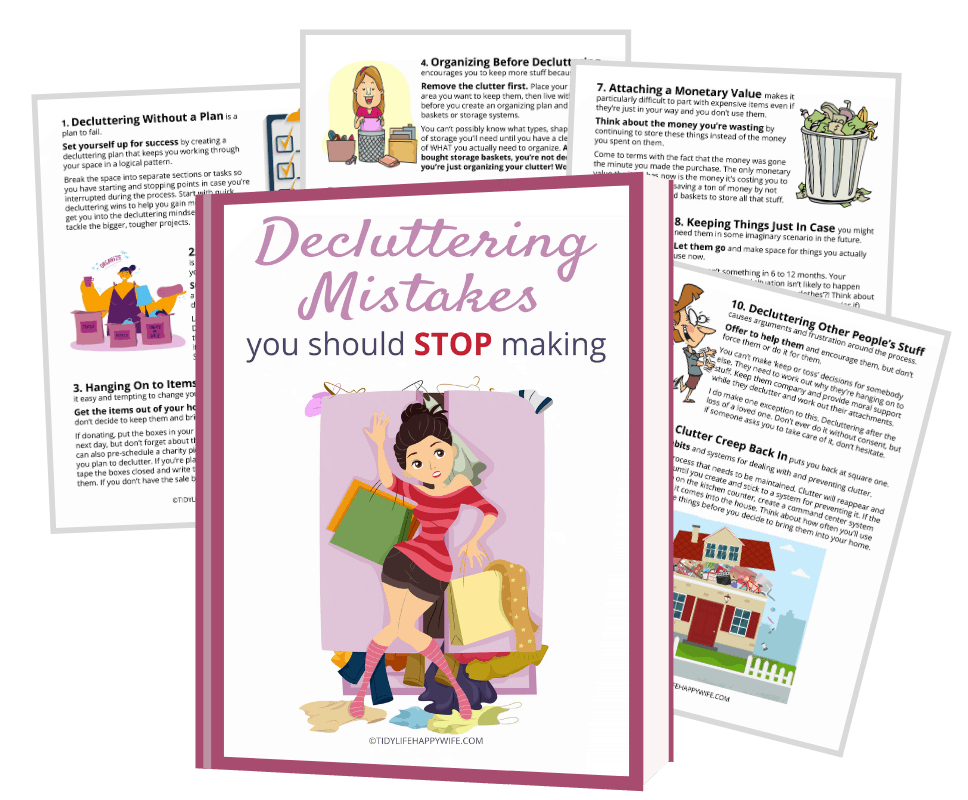
Join thousands of VIPs for cleaning, decluttering, and organizing tips sent straight to your inbox. As a welcome gift, we’ll send you this FREE printable Decluttering Mistakes Guide that tells you exactly what NOT to do when decluttering.
What is Sentimental Clutter?
Sentimental clutter can be any item that’s no longer useful but you keep around because you’ve formed an emotional attachment to it. It can also be an excessive amount or collection of similar things.
Any physical item that creates negative feelings, causes you distress or feels like a burden can be considered sentimental clutter.
I’ve already mentioned a few examples above, but the possibilities are limitless. What other items can you think of?
I’ll give you a few more examples to help you identify the sentimental clutter in your life.
Think about every picture you’ve taken in your lifetime? Are they all stashed in bins or boxes in your garage or do you pile them up in the back of a closet?
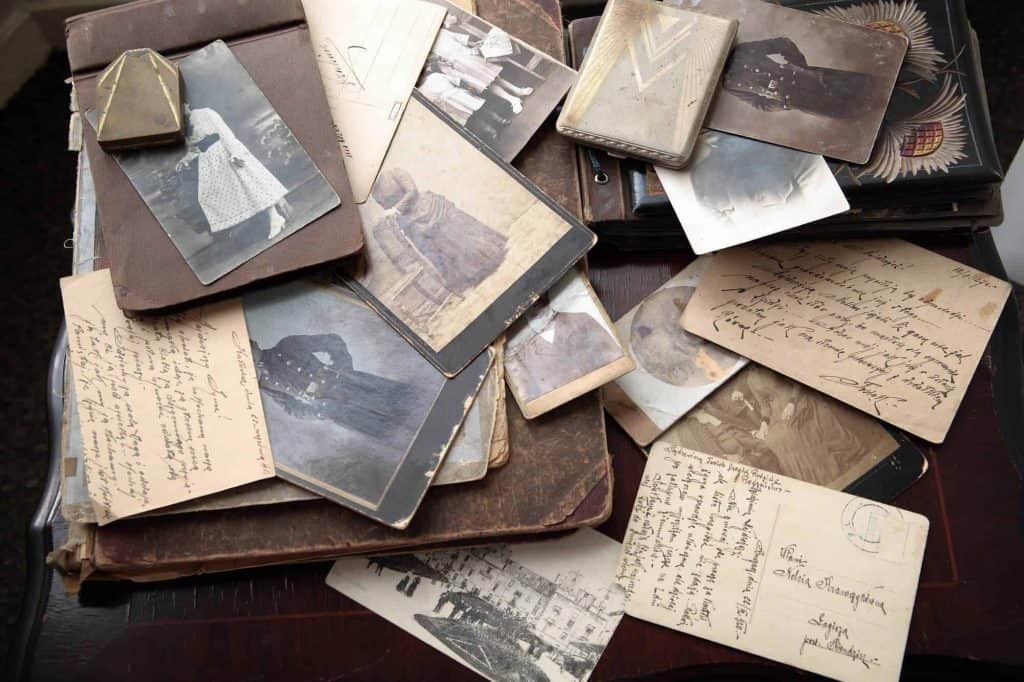
What about all of the programs you saved from every sporting event you’ve ever been to?
Maybe you’ve kept every card or stuffed animal you ever received from a boy dating all the way back to those childhood homemade Valentine’s day cards?
Or maybe you still have a trunk full of favorite shirts that belonged to a lost loved one?
Sentimental Attachment to Clutter
I possibly just triggered some raw emotions but hear me out and keep reading. You might like what I have to say.
We’re all human. We associate items with people, and we attach our feelings for those people to those items.
It’s ok to keep some of those around. When they become a burden or make you unhappy, they’ve crossed the threshold from memories and precious keepsakes to sentimental clutter.
My father loved classic muscle cars. When he passed away, I hung on to his diecast collection for a few years.
Every time I tripped over those boxes stacked in my garage, it made me a little sad. I realized it was time to let go, so I pared it down from hundreds to just a few favorites that are displayed in my office.
Sentimental Clutter is Costing You
It’s hard to let go, but make no mistake, sentimental clutter is clutter, and it’s costing you in several ways. It can impact your mental and emotional health, ruin your relationships, and deplete your wallet.
Mental and Emotional Health
Sentimental items don’t always have happy feelings and emotions attached to them. A majority of them can have both.
The feel and smell of your mother’s favorite sweaters probably take you back to happy childhood days and make you smile. Seconds later you’re ugly crying because you’ve been stuck in the grieving stage for the last five years.
Maybe it’s time to move on and celebrate all she did while she was here.
Relationships
Relationships can suffer too.
Often a spouse or loved one doesn’t have emotional attachments to items. They aren’t built that way and they don’t understand why you need the items to retain the memories.
Do you argue about the amount of clutter, the specific items, or the way they impact you emotionally?
Is your sentimental attachment to certain items more important than the relationships that are being affected?

Wallet
This is actually a big one. The true dollar cost of clutter is outrageous. Even if you’ve optimized the organization of your clutter, it’s costing you dearly.
Remember when I said our homes have become oversized, overpriced storage units? Let’s explore that a bit more.
Write down the price you paid for your home, then divide it by the square footage. This is the cost per square foot of your living space.
$350,000 cost of home / 2500 sq ft size of home = $140.00 per square foot to store your clutter!!!
Now measure the square footage (length times width) of every space that’s being used to store sentimental items. Don’t forget the garage and any outbuildings that are used for storage.
Multiply that by the cost per square foot that you figured out in the last step. OUCH right! We’re not even done yet.
Now add the cost of any storage bins, trunks, sheds, etc. that you purchased to organize your clutter.
That’s the true monetary cost of your sentimental clutter.
Now that you can identify your sentimental clutter and realize what it’s actually costing you, here are some proven strategies to help you declutter your sentimental items.
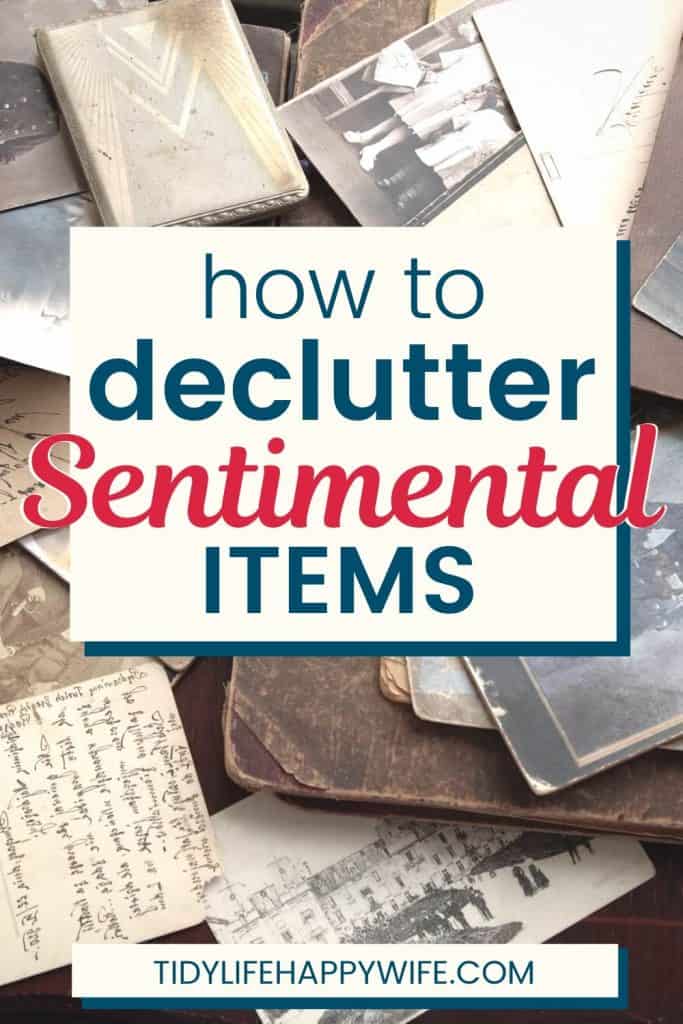
Strategies for Decluttering Sentimental Items
I write a lot about decluttering.
It’s one of the biggest problems and frustrations we deal with as adults, but decluttering sentimental items is in a class of its own.
Here are some strategies to help you navigate through it.
**Check out these related articles on decluttering your living room, kitchen, and bathroom. At a loss for what to do with the clutter once you’ve removed it from your home, here are some options.
1. Recruit A Friend to Help You Declutter Sentimental Items
Enlist a trusted friend or family member to help you out. They can be a shoulder to lean or cry on, a different perspective, and a reality check when you get lost in your thoughts and sentiments.
They can also serve as a bit of a barrier to the emotional side of decluttering.
On her Netflix show, Tidying Up with Marie Kondo, Marie will often hold an item and ask ‘Can you let this go’. She’s actually using 2 different strategies to help the person declutter.
First and foremost, by holding the item herself, she’s eliminating the possibility of the touch of the item causing an emotional response (remembers mom’s favorite sweaters).
Secondly, she doesn’t say anything about keeping the item. The question ‘Can you let this go?’ is more of a suggestion than a question, and if the answer isn’t an immediate ‘No’, it’ll likely be a YES.
Your helper can do this for you, and they’ll likely know how to keep you on task but be able to see when you need a short break.
2. Work At Your Own Pace While Decluttering
I know I said to get help, and I mean it, but make sure you work at your own pace.
Be mindful of suggestions to move along and keep the progress going, but if you’re really struggling to let something go, set it aside and move on to the next item. You can return to the most difficult items later.
Don’t make rash decisions. You want the decluttering process to have a positive impact and end result.
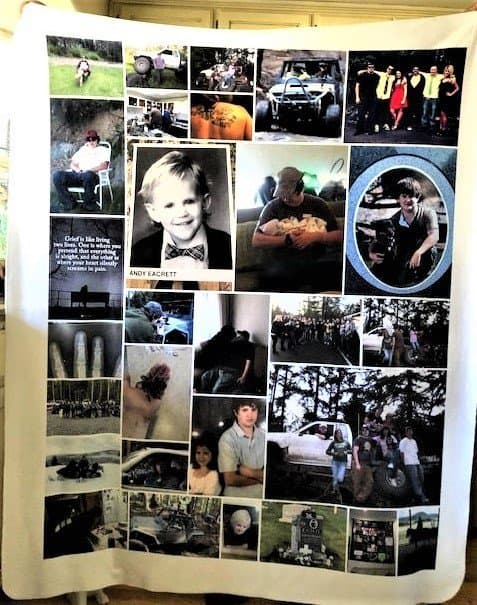
3. Gather Sentimental Items One Place
Start by gathering similar items all in one place. If you’re tackling baby clothes today, place them all in one spot so you can truly understand how much you have.
Having it all out at one time also tends to put things in perspective. Not only will you realize how much stuff you have, but seeing it all together can also clarify the importance of each item.
Using the children’s clothing example, you might have six of your daughter’s favorite dresses from different times in her life. If you look at each one individually, you’ll likely save them all because of the memory each one brings about.
On the flip side, if you look at all six of them together, you might be able to select the most favorite one and let go of the other five.
AVOID THE COMMON DECLUTTERING MISTAKES OTHERS MAKE!

Join thousands of VIPs for cleaning, decluttering, and organizing tips sent straight to your inbox. As a welcome gift, we’ll send you this FREE printable Decluttering Mistakes Guide that tells you exactly what NOT to do when decluttering.
4. Understand and Define the Emotional Attachment to the Memories
Understand and define why you’re keeping something and how it makes you feel.
Does the item really hold the memory or feeling you’ve associated with it, or is it just stuff? Do you need that particular thing to conjure up that particular memory?
Sometimes things that bring happy memories can cause frustrations or feel like a burden because of sheer volume. If the amount is causing negative feelings, it’s time to downsize.
5. Repurpose the Sentimental Items
This is my favorite strategy. Repurpose the items to create a visual representation of the things on a smaller scale so you can get rid of the bulk of the items and still preserve the memories.
Shadow Boxes – Shadow boxes are deep frames that are designed to hold and protect small trinkets, pictures, and memorabilia. You can use a shadow box to preserve mementos from a specific time or event and eliminate the rest.
Digital Files – Digital files include digital picture frames, external drives, and thumb drives. You can use a scanner to transfer collections of photos, letters, cards, etc on to digital media and get rid of the physical copies.
There are also several companies that will do this for you including Legacy Box and Costco.

Memory Quilts – A memory quilt is a compilation of items that have been transferred on to fabric and used to make a quilt. I think my good friend Cindy has one of the best examples of this.
She tragically lost her young adult son Andy. She honors and remembers him with this quilt made out of pictures of him that were transferred on to fabric, his favorite t-shirts, letterman’s jacket and other memorabilia from his life.
You can check out some others at Sealed With Stitches.
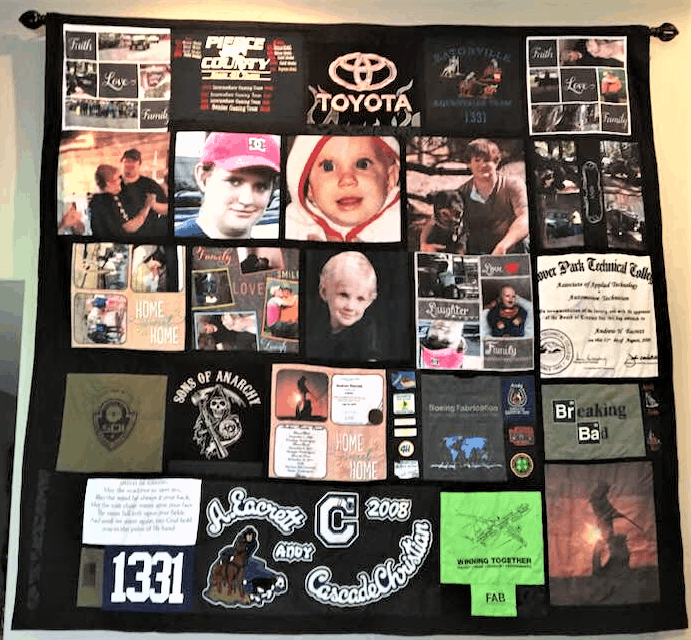
6. Minimize the Amount of Sentimental Clutter
That doesn’t mean become a minimalist and get rid of everything right now.
It just means that grandpa’s favorite fishing pole can bring back the same memories and feelings that the entire collection does. Just keep a few of your most favorites.
7. Pass the Sentimental Items On
Sometimes you’re holding on to sentimental items out of a feeling of obligation or guilt.
If the enjoyment you get from these things has run its course, try passing them on to other family members and let them enjoy them for the years to come.
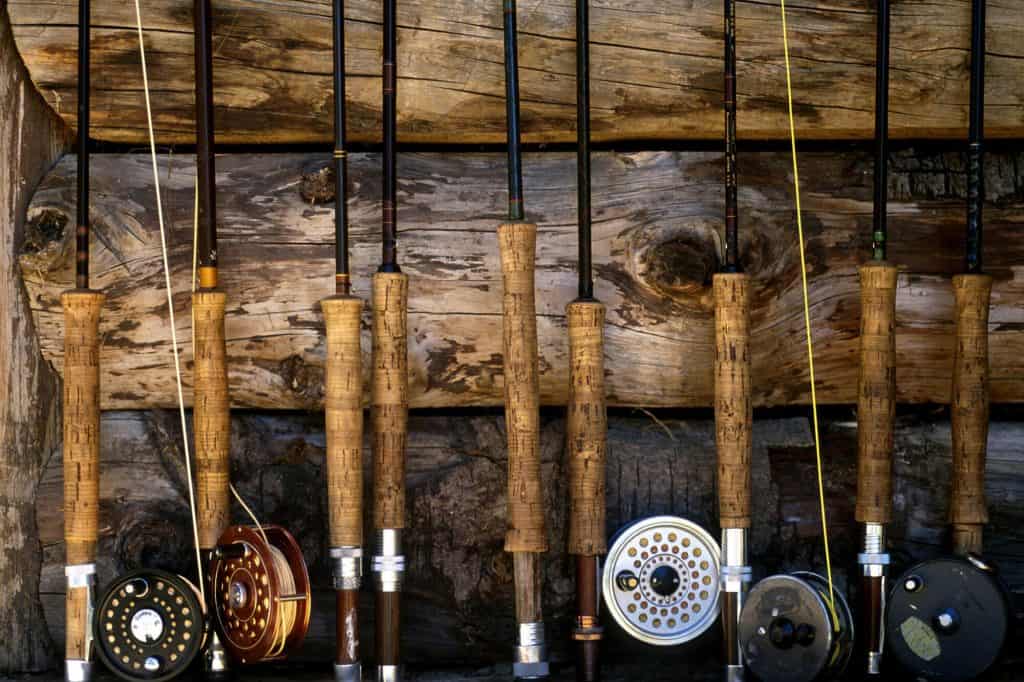
8. Give Yourself Grace
Decluttering sentimental items is incredibly difficult and challenging. Give yourself a little grace during this process.
Even if you only got rid of a few items, you made progress. Celebrate that.
If you find you’re having trouble letting an item go, but still wrestle with the cost of keeping it, give yourself a little grace and set it aside to deal with later.
You don’t have to declutter everything in one session.
9. Wash, Rinse, Repeat
The final and most impactful strategy is to do it again. Decluttering is not a once and done thing.
Do one session, then plan a time and date for another session. Each time to repeat, you’ll be able to declutter a little more. When you gather all the items in one place, your brain automatically signs a rank or tiered value to each item.
Let’s say your first session started with thirty of grandpas fishing poles and you eliminated five but decide you couldn’t let go of the other twenty-five. The next time you gather them together, you’ll automatically decide which ones are the least important.
Each time you go try decluttering sentimental items, a different group moves to the bottom and can be let go.
* Bonus Tip from a Reader
Here’s a great tip from a reader!
If you have generations of family photos that none of your immediate family want, look into uploading them to a genealogy site like Ancestory.com.
You never know which long lost relative or friend of the family may stumble on those pictures!
Final Thoughts on How to Declutter Sentimental Items
Now that you have a clear understanding of what sentimental clutter is and what it’s really costing you, plan a decluttering session of your own.
Get a trusted friend to help you through this process, but work at your own pace. Decluttering sentimental items is difficult and can require some time.
Gather all of the items in one place and define why you’re emotionally attached to these sentimental items.
Repurpose the items into a beautiful memory piece and minimize the amount you choose to keep. You can even pass some of it on to other family members.
Give yourself a little grace through this grueling process and remember that even a little progress is still progress. Then, do it again, and again, and again. Each time you’ll be able to let go of a little more.
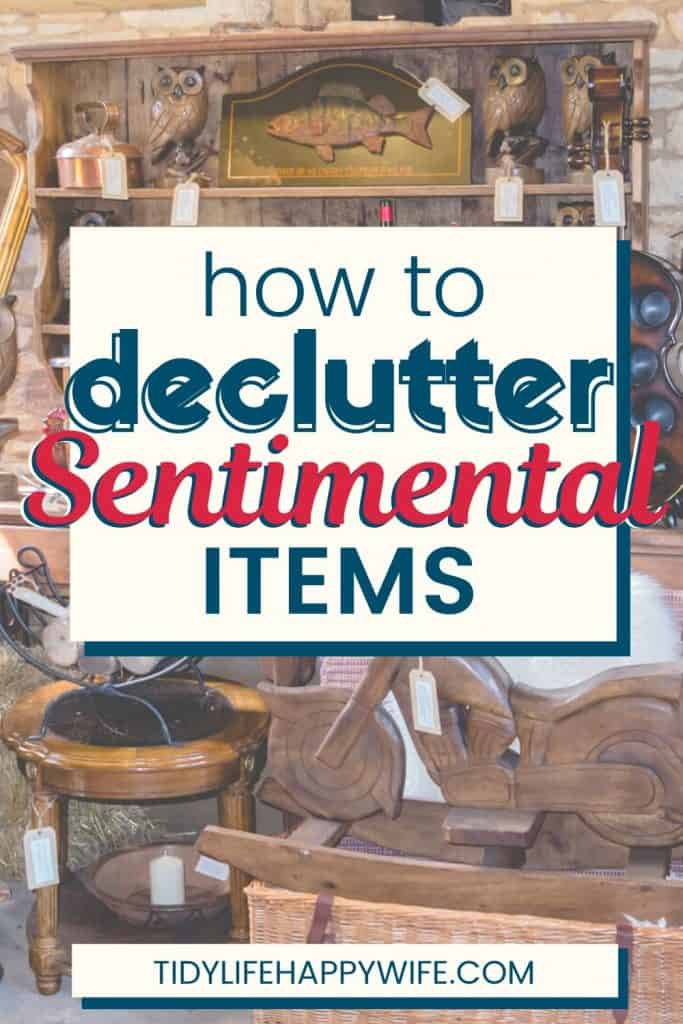

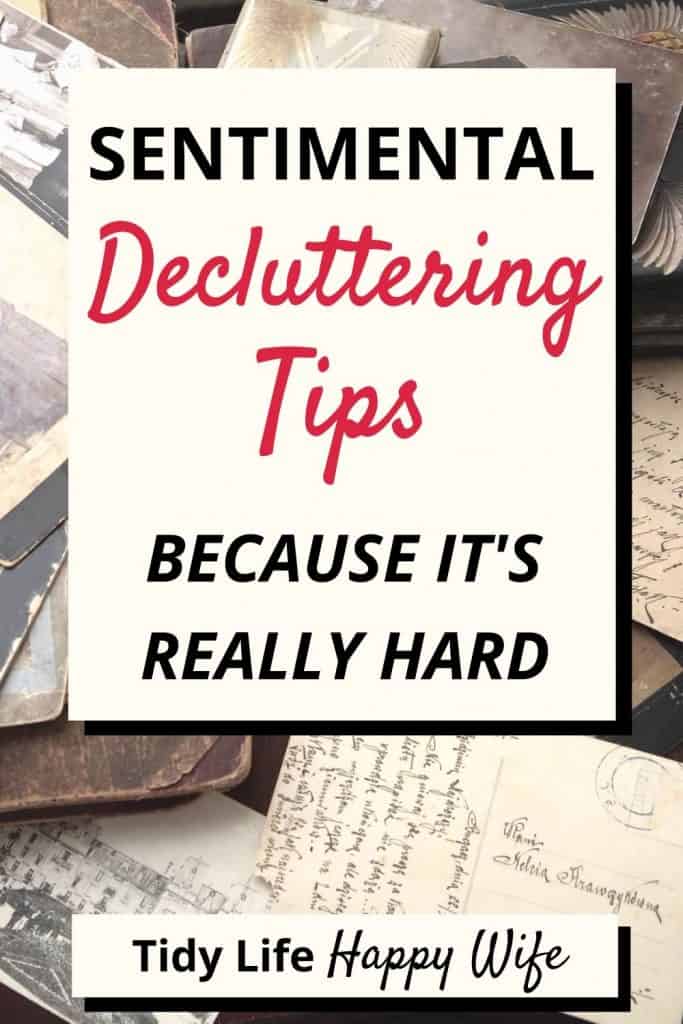


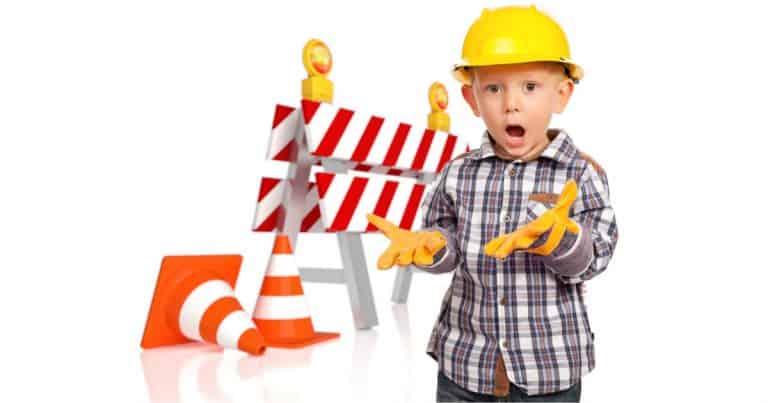
![Efficiently Declutter Your House in Just One Week [Day by Day Plan]](https://tidylifehappywife.com/wp-content/uploads/Declutter-768x512.jpg)


Thank you for all this information it comes at a perfect time. We have a 30 x 40 garage filled to the rafters. I figured it to be about 116 years of collection between my daughter and I. And we are at this time in the mood and mind to get rid of it all. Well almost all. We had a yard sell no one showed up. Now we are putting it on marketplace which has been surprising at the response. The rest to a second hand store. Think we have picked one that will benefit the most and does the most for others.
By doing this a load at a time we can get rid of it much faster we are hoping.
We start tomorrow. Really looking forward to it, and this system well really help. Thank you!
Sounds like you definitely have the right mindset, Kathy. You can also donate stuff to local homeless and women’s shelters as well as nursing homes. Good luck on your journey, and don’t hesitate to send me an email if you get stuck.
Hi Tanya:
You asked for my help.
I wrote my story and how we are handling items including especially sentimental items.
Sadly I have sent our story twice and it comes back undelivered can you give me an address to send it to
Kathy,
I’m so sorry. I’m not sure what happened. The email address is tanya@tidylifehappywife.com, but just replying to the email you received from me should have worked. I’ll try sending a test email.
I have pictures dating back many generations. My child does not have children and there will be no one to inherit them so we have decided to post them on sites like Ancestry.com where they won’t be ‘lost’ to the ages. Just waiting to get together and decide where to post. Then, I will save the ones of ancestors I knew.
That’s a phenomenal idea, Denise! Let us know which sites you end up using.
Hi. I just finished reading all your suggestions on letting go. I have a bit of a situation that I don’t think is unique, but don’t know how to handle.
My husband is a hoarder and has things from his grandparents, aunts & uncles who have long passed. As well as collections of magazines, fishing paarifinallia and out door gear that would rival any Cabellas. I don’t know how I can bring the topic up… when is enough, enough!
Help!
Thank you
HLF
I feel you! I find the best way to get somebody else to declutter is to ask them to help you organize the area their stuff is stored in. Sometimes they just don’t realize how much they have and how much room it’s taking up. Take one category at a time and start with the things he’s probably the least attached to. Once he starts parting with things, keep gently building that momentum. My article on how to stop nagging your husband might give you some ideas I’ve used in the past. I talk about some of the tricks I use instead of nagging.
Another thing that has helped me a lot is to take a photo of the item before getting rid of it. Then I have a file in my harddrive called “Memories.” That gives me assurance that I won’t forget about something that feels important to me.
That’s a great idea Angela. Make sure you keep a backup on a thumb drive or some kind of cloud storage.
Seriously, how much room do photos take up? To even think of tossing photos of grandma or great grandpa is an affront to civility. Get your butt in gear and organize and label them as best you can. Or ask around for a relative who would like to take that project on. Please don’t dismiss these valuable genealogical records. Once here gone, so goes your history.
Dottie Clark
Do what works for you. If physical photos bring you joy, keep them. If they’re giving you anxiety because they are stacked in a closet you really need for something else, transfer them to digital, and get rid of the physical copies.
Hi Tanya – I am so glad I came across your website. I have done pretty good at de-cluttering but am at a place where I am stuck. I have family photos and some mementos and I am not sure where to start – I am single, never married, most of my family is deceased and I only have a few cousins that live out of state and I am not in constant contact with. After each of my parents passed, holding on to a lot of items wasn’t an issue for me. I have wonderful memories from my childhood and my adulthood with my parents and do not find the need to hold on to a lot of what they had. I think my issue is with just throwing everything away (except those items that can be donated). There is a bit of guilt associated with throwing photos and such away. I won’t miss them and I have decided that those photos I come across that I truly want to keep I will scan and put into a digital photo album. I also think of the future and that there is no one that any of my stuff would pass down to, so I think about that and what I want to leave behind for whoever will discard of my stuff. I guess I am just looking for reassurance that what I am doing is not strange. Most people have family to pass things on to and I think this is where I struggle is because there is not a lot out there for people that have no one in their life and what they should do. Thanks for reading this long post and I look forward to your suggestions. Take care and be well.
Mary,
Just toss them out! You might deal with a little guilt, but it’ll pass. Right now, those pictures are weighing on your mind while you struggle to decide what to do with them. Once they’re gone, you won’t even give them a second thought. I can say that with certainty because I’ve done it.
Years ago, my father collected photos from several family (and extended family) members and created identical albums for everybody. When he passed away, I became the owner of those albums, all of the negatives, and all of the copies he’d made. We’re talking several generations of photos. I kept a small photo box of some favorites and threw the rest out. I’m not a minimalist by any stretch of the imagination, but the minute the weight of wondering what to do with all of those photos was lifted, I knew I’d made the right decision.
If you still aren’t ready to do that, sort through them all and put the ones you don’t want to keep in a cardboard box. Label the box ‘Pictures to Toss’ and date it. Tape it shut and put it in a place you’ll see it on a regular basis. When you’re ready, you’ll be able to toss it without opening it. If not, you’ve already boxed them up for somebody else to toss.
Mary,
Please please don’t toss out those pictures without asking all of your cousins and extended cousins if they would like them. I have met family members that I didn’t know I had by doing genealogy research. I have had relatives from California send me pictures of relatives. I got to see what my great great grandmother looked like. If you never ask around you don’t know who’s related. If they don’t want them you can do what was suggested in the post by adding them to ancestry or family search so they are not lost forever. I found out that I’m related to Pocahontas. How cool is that we have a picture of her!
All the best
Oh, wow. It is like you wrote this for me! I wrote similar on my post because we are downsizing. Grandma’s china. EVERY picture, paper, my kids drew, baby clothes (from them), my high school stuff. Boxes and boxes! and now with moving, it has to go. 🙁
Moving is a big job all by itself Terri. Add downsizing and you’ve got your hands full. A reader once told me to imagine my house is on fire and I have 10 minutes to grab whatever is important to me. If it doesn’t make the 10-minute cut, it isn’t important! That will surely give a person some perspective.
Very helpful article. Thank you! I am one of the people you mentioned who has every drawing my kids every made and every greeting card that was ever sent to me in my life 🙂
Lisa, those are some wonderful memories. If you’re ready to take back some space, check out Legacybox. They will transfer them all to digital media for you.
Kari, my husband is in a nursing home with dementia and due to financial struggles, I am now sharing a rent house with my 40 yr old daughter. I also have 2 sons. They have suggested I have 2 more months to get rid of “my life”. The problem is a mother hopes to pass along many things that she hoped her children would want, but not in my case. The boys say they have enough “junk” and don’t need anymore and my daughter is a minimalist. Even pictures of great great grandparents and more they said they don’t want because they never knew them. How do I handle and cope with such sentimental things that will be gone forever?
I am all about de-cluttering, to a certain extent. The generations of today are losing the memories of yesterday with a mindset of minimilistic thinking. I think it is good to get rid of junk, but sentimental items aren’t always bad to hold on to. I think that the mindset of today’s adults have lost much of their history by not being reminded of the past. I don’t think you should hold on to everything, but some things are a good reminder of where we came from. I think it is sad to go into some homes that don’t have any pictures of family on the walls, but have modern pictures that mean nothing. It is a cold environment that holds nothing sacred anymore. But then, I am just a 68 year old woman that surrounds herself with love from the past, and enjoy looking at pictures of my wee ones and reminiscing of being a young momma. With 22 grandchildren, I proudly display their art work and sweet letters on my pantry wall to look at and it brings smiles to me constantly. We are all different in what we enjoy, but to me sentimental items are some of my happiness.
I struggle with #7, family items that my mom wants me to keep but I have not attachment to them. I should reach out to other members of her family and see if they want them. Thanks for sharing this, I feel better knowing that items won’t go to “waste” in my garage, and that others may find enjoyment out of them.
Kari, it’s actually very effective. You might be surprised at which family member has wanted a specific item all along but didn’t have the courage to ask. And if that doesn’t work, there’s always Craigslist or Facebook Marketplace. Good luck in your re-homing journey:)